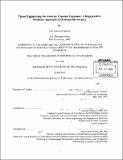| dc.contributor.advisor | Charles Alfred Vacanti. | en_US |
| dc.contributor.author | Canseco, José Antoni | en_US |
| dc.contributor.other | Harvard--MIT Program in Health Sciences and Technology. | en_US |
| dc.date.accessioned | 2014-01-14T15:25:18Z | |
| dc.date.available | 2014-01-14T15:25:18Z | |
| dc.date.issued | 2013 | en_US |
| dc.identifier.uri | http://hdl.handle.net/1721.1/83965 | |
| dc.description | Thesis (Ph. D. in Biomedical Engineering)--Harvard-MIT Program in Health Sciences and Technology, 2013. | en_US |
| dc.description | Vita. Cataloged from PDF version of thesis. | en_US |
| dc.description | Includes bibliographical references (pages 85-97). | en_US |
| dc.description.abstract | Anterior cruciate ligament (ACL) injuries affect over 200,000 Americans yearly, and many occur in young athletes. Current treatment options include tendon autografts and cadaveric allografts. However, these approaches often lead to secondary medical problems, such as donor-site morbidity and immune rejection. Furthermore, in younger patients these grafts fail to grow, leading to additional complications and underlining the need for the development of new approaches that improve the healing and repair of ligaments and tendons. This thesis aims to develop a technique to engineer ACL from autologous mesenchymal stem cells (MSC) and primary ACL fibroblasts using the basic principles of Tissue Engineering. The first part of the thesis characterizes MSCs isolated from tibial bone marrow as an alternative to hip-derived marrow aspirates. The proximity of the tibia to the surgical site of ACL reconstructions makes it a viable source of marrow derived-MSCs for ligament repair, with less stress for the patient and increased flexibility in the operating room. Characterization was performed by fluorescenceactivated cell sorting for MSC-surface markers, and assays to differentiate MSCs towards adipogenic, osteogenic and chondrogenic lineages. The second part of the thesis describes the effects of in vitro co-cultures of ACL fibroblast and MSC on the expression of ligament-associated markers. The goal was to optimize the cell-cell ratio in order to maximize the positive effects of co-cultures on ligament regeneration. Co-cultures of ACL fibroblasts and MSCs were studied for 14 and 28 days in vitro, and the effects assessed with quantitative mRNA expression and immunofluorescence of ligament markers Collagen type I, Collagen type III and Tenascin-C. Finally, based on the enhancing effect observed in co-cultures, the thesis explores a method to regenerate ACL using a three-dimensional polyglyconate scaffold seeded with cell-hydrogel suspensions containing ACL fibroblasts and MSCs. Constructs were analyzed biochemically and by immunofluorescence after 4 weeks in culture with and without mechanical stimulation. Together, our results establish an experimental framework from which a new technique for ACL repair can be developed. The ultimate goal is to foster the design of a one-stage surgical procedure for improved primary ACL augmentation repair that can soon be translated into clinical practice. | en_US |
| dc.description.statementofresponsibility | by José Antonio Canseco. | en_US |
| dc.format.extent | 99 pages | en_US |
| dc.language.iso | eng | en_US |
| dc.publisher | Massachusetts Institute of Technology | en_US |
| dc.rights | M.I.T. theses are protected by
copyright. They may be viewed from this source for any purpose, but
reproduction or distribution in any format is prohibited without written
permission. See provided URL for inquiries about permission. | en_US |
| dc.rights.uri | http://dspace.mit.edu/handle/1721.1/7582 | en_US |
| dc.subject | Harvard--MIT Program in Health Sciences and Technology. | en_US |
| dc.title | Tissue engineering the anterior cruciate ligament : a regenerative medicine approach in orthopaedic surgery | en_US |
| dc.title.alternative | Tissue engineering the ACL ligament : a regenerative medicine approach in orthopaedic surgery | en_US |
| dc.title.alternative | Regenerative medicine approach in orthopaedic surgery | en_US |
| dc.type | Thesis | en_US |
| dc.description.degree | Ph.D.in Biomedical Engineering | en_US |
| dc.contributor.department | Harvard University--MIT Division of Health Sciences and Technology | |
| dc.identifier.oclc | 863154325 | en_US |
